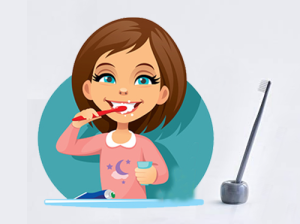Tooth Brushing and Braces

Brushing your teeth is an integral part of oral hygiene and people who don’t brush regularly have an increased risk of stained teeth, tooth decay, gum disease and other serious health problems.
The design of the fixed orthodontic appliances is such that the food accumulation is easy. The part of the tooth under the band is protected but the uncovered part between the braces and the gum need special care. This is a danger zone. If this is ignored it can damage the teeth, gums and underlying bone. With the braces, it will take a little extra effort from your side for the brushing.
Plaque is a sticky white substance that collects on your teeth. It is made up of bacteria, food and saliva. If plaque entrapped food are left on your teeth and around your braces, they can cause swollen gums, bad breath, marks on your teeth and cavities. Plaque can also discolor your teeth and make them look yellow.
You should remove every trace of plaque entrapped food from all the surfaces of your teeth. Pay a very close attention to brushing the gum line because plaque left there will make your gums sore and swollen which will make brushing even more difficult. You can use special type of brushes, dental floss, mouth washes and fluoride mouth rinse if they are recommended by your orthodontist. Do not use a toothpick or any sharp pin to clean the area around the braces. Brush after every meal especially if you have eaten anything sticky or sweet. If you cannot brush, be sure to at least rinse well with water until you can brush.
Points to Remember:
- After brushing you should rinse thoroughly
- Then inspect your teeth and braces carefully to make sure they are spotless
- Do this by looking closely in a well-lighted mirror
This is important as you cannot feel plaque, but you can usually see it.
Key Brushing Points:
- Use a super soft bristle brush having a small head and a long handle so that it can reach the last tooth.
- Hard bristle brush can usually wear down your enamel and damage your gum tissue. The result is sensitive teeth and gums which hurt when you drink something hot or cold.
- Harder brushing is not good whether with the braces or not as it will erode your outer protective enamel.
- Dispense the paste only to the peanut size. Do not take it to the full length of the brush head which can cause extra foam.
- IDA recommends that the brush must be changed once in three months as bristles get frayed and broken bristle just can’t clean.
- Two minutes twice a day is the recommended time for tooth brushing.
- Make it a routine to clean your tongue also as bacteria reside there.
- Make sure your toothbrush air dries in an upright position. Don’t store your wet brush in a confined space such as drawer or cabinet as it will become a breeding ground for bacteria.
Remember, you and your orthodontist, both, want a beautiful smile.
So start working on it from today.
You can schedule a consultation appointment with Dr. Seema Bansal for more informantion.

It self explanatory n useful article.
Thank you Preeti
These blogs are easy to understand. Thank you doctor for explaining important techniques in a very simple manner.
Thank you Brinda for your comment
Any layman will understand its so beautifully explained which makes it very useful n thus can be adopted easily… precaution is always better .. Thank you Dr Seema ji for this useful article…
Thank you Sonal for commenting. I am glad you found the information relevant .
Very informative article. Thank you Doctor for the article.